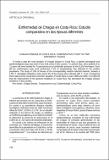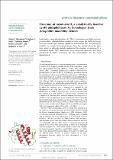Buscar
Mostrando ítems 1-10 de 260
Enfermedad de Chagas en Costa Rica: Estudio comparativo en dos épocas diferentes
Chagas disease in Costa Rica: comparative studyin two different stages
(2006)
Para actualizar la situación de la Enfermedad de Chagas en Costa Rica se realizó un estudio serológico y epidemiológico parcial en 4 zonas de riesgo en el país. Un total de 1.561 estudiantes de 6 a 12 años fueron estudiados ...
Zoonotic Agents in Feral Pigeons (Columba livia) from Costa Rica: Possible Improvements to Diminish Contagion Risks
(2018-01)
Most studies on zoonotic agents in pigeons have been conducted in the Palearctic region, but the scarcity of data is notorious in the Neotropical region, where these birds can breed all year around and are in close contact ...
Proteomic profile of the venom of three dark-colored Tityus (Scorpiones: Buthidae) from the tropical rainforests of Costa Rica
(2023)
Objective: We aimed to elucidate the potential differences in the venom peptide sequences of three Tityus species
from Costa Rican rainforests: T. jaimei, T. championi and T. dedoslargos, compared to T. cf. asthenes ...
Acanthamoeba genotype T4 keratitis in a patient with Thygeson’s superficial punctate keratitis
Queratitis por Acanthamoeba genotipo T4 en un paciente con queratitis punteada de Thygeson
(2017-01)
A case of amoebic keratitis due to Acanthamoeba genotype T4 is reported. The patient is a 74-year old
woman with Thygeson’s superficial punctate keratitis. Corneal scrapings were employed for the diagnosis, which included ...
Depletion of complement enhances the clearance of Brucella abortus in mice
(2018)
Brucellosis is a bacterial disease of animals and humans. Brucella abortus
barely activates the innate immune system at the onset of infection, and this
bacterium is resistant to the microbicidal action of complement. ...
Structure of myotoxin-II, a catalytically inactive Lys49 phospholipase A2 homologue from Atropoides nummifer venom
(2006)
Lys49 snake-venom phospholipase A2 (PLA2) homologues are highly myotoxic
proteins which, although lacking catalytic activity, possess the ability to disrupt
biological membranes, inducing significant muscle-tissue loss ...
Exposure of a Tropical Soil to mg/kg of Oxytetracycline Elicits Hormetic Responses in the Catabolic Activities of its Microbial Community
(2011-04)
Many farmers in developing countries protect their crops with oxytetracycline and fertilize their farmlands with manure from animals that received this drug as growth promoter. In this study, a tropical soil was exposed ...
Venomics of the poorly studied hognosed pitvipers Porthidium arcosae and Porthidium volcanicum
(2021)
We report the first proteomics analyses of the venoms of two poorly studied snakes, the Manabi hognosed pitviper Porthidium arcosae endemic to the western coastal province of Manabí (Ecuador), and the Costa Rican hognosed ...
A single exposure of sediment sulphate-reducing bacteria to oxytetracycline concentrations relevant to aquaculture enduringly disturbed their activity, abundance and community structure
(2015-05)
Aim: although feed medicated with antibiotics is widely used in animal production to prevent and treat bacterial infections, the effect of these drugs on nontarget anaerobic bacteria is unknown. We aimed to clarify whether ...
Proteomic and toxicological analysis of the venom of Micrurus yatesi and its neutralization by an antivenom
(2022)
Coralsnakes belong to the family Elapidae and possess venoms which are lethal to humans and can be grouped based on the predominance of either three finger toxins (3FTxs) or phospholipases A2 (PLA2s). A proteomic and ...





